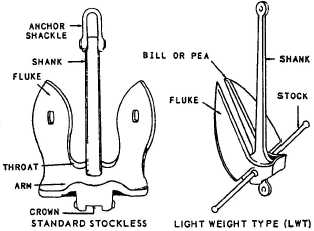| |
bow and are secured (housed) in the hawsepipe.
Stern anchors are carried on the stern. On
landing ships and craft, stern anchors are used
to assist them in pulling away from beaches.
The most common types of anchors used
aboard ship are the
stockless
and
the
lightweight (or stock in crown). The two anchors
shown in figure 18-2 are of Navy design. The
stockless types are used chiefly as bow anchors
(bowers) on most Navy ships. Originally, the
lightweight types were used only on small boats
and as stern anchors on landing ships and craft.
Recently, however, they have made their
appearance as bowers for several types of
vessels.
ANCHOR CHAIN
Modern Navy anchor chains consist of
studded links of high-strength steel. (Studs are
crosspieces of metal forged or welded in the
center of the links to prevent the chain from
kinking.) The chains are made up of 15-fathom
(90-foot) sections called standard shots. The
number of shots per chain depends on the size of
the ship. Shots are secured together by
detachable
links
that
can
be
readily
disassembled whenever the chain must be
broken.
STOWING CHAIN
As the chain comes aboard, it passes
along the deck on metal flash plates, over the
wildcat, and down into the chain locker, as
shown in figure 18-1. Its bitter end is secured to
a ring bolt on the bulkhead of the chain locker.
Figure 18-2.—Anchor types.
ANCHOR WINDLASSES
The Navy uses two types of anchor
windlasses for lifting the ship’s anchor. Most
combatant ships use the vertical shaft type (fig. 18-
1). Amphibious and auxiliary ships use the
horizontal shaft type. Both types are equipped with
wildcats, which engage the link of the anchor
chain. The wildcat may be disengaged when the
capstan (vertical type) or the gypsy heads
(horizontal type) are used for handling lines or
wire.
BOATS AND SURVIVAL EQUIPMENT
Some ships carry boats used to transport
personnel. These boats can be used for routine or
survival purposes. Another type of boat, the
lifeboat, is used strictly for survival purposes.
BOATS
The term boat refers to a noncommissioned
waterborne vessel that is not designated as a
service craft. A boat is capable of limited
independent operation. Officer and personnel
boats, motor whaleboats, and utility boats fit into
this group. Boats carried aboard ship that can be
hoisted from and lowered into the water are known
as ship’s boats.
LIFEBOATS AND LIFE RAFTS
A warship does not have room for all the
powerboats needed to transport the entire crew in
a survival situation. At sea, a power boat is usually
difficult, and sometimes impossible, to launch
rapidly. For these reasons, the Navy has spent
time and expense developing efficient lifeboats
other than powerboats.
Several types of inflatable lifeboats or life
rafts are used by the Navy. Each boat or raft is
stocked with enough survival equipment to support
the number of survivors the boat was designed to
carry. The survival gear includes a canopy, a sea
anchor, a lifeline, boarding line, a rain-catcher
tube, air hand pumps, paddles, sponges, a repair
kit for patching leaks, and a floatable knife. The
Mk 6 Mod 1 inflatable life raft also carries desalter
kits for turning seawater into freshwater. In the
survival kits are food rations, sea marker dye, a
flashlight, batteries, a signal mirror, a whistle, a
first-aid kit, a distress signal kit, and containers of
freshwater. The survival kits in the Mk 6 25-man
life raft can sustain 25 people for 5 days on regular
rations. The general arrangement of the Mk 6 life
raft is shown in figure 18-3.
18-2
|

